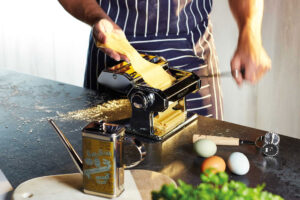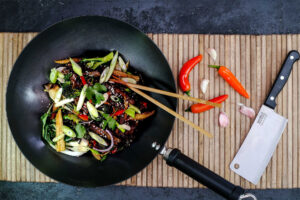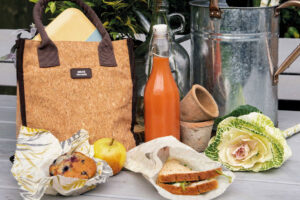Pans and pots can last a long time as long as they receive correct care. To increase the lifespan of a pan it is important to remember the material of the tool and requirements this material poses – the care instructions differ by material. What could be considered consistent throughout the wide range of cookware is the recommended time to clean them – this task should be undertaken once the pot or pan has already cooled down (slight exception here with cast iron, more below). Adding cold water to a hot pan can damage the coating and therefore decrease the lifespan. It is also important to use the correct sized stove ring – the diameter of the pan and ring should be similar. This way you avoid damage to the sides of the pot or pan, as well as overheating of the handles.
Another rule to keep in mind is that the pan or pot should never be heated up empty. To avoid this, add a dash of oil or water to the pan before you even switch on the stove.
Some pans are also suitable for dishwashing and marked with the dishwasher sign usually on the bottom of the pan. These pots and pans can be placed in the dishwasher for the washing cycle, but should be removed from the machine immediately once the programme finishes to hand dry. Also hand washed pots and pans should be dried immediately as the moisture can damage their porous surface.
Non Stick Pans
The choice of materials available today for non-stick pans is much wider – for example, within our selection you will find ceramic, cast aluminium, as well as environmentally friendly water based Hydrolon coated non-stick pans. To prepare your new pan for use, first wash it with a gentle sponge and lightly soapy water, thoroughly dry it and then oil on the entire inside of the pan with a teaspoon of oil. Place the oiled pan on medium heat for 1-2 minutes and let it cool down. Your pan is now ready for use. We recommend to oil the surface of the pan after each wash, but this time just a drop of oil will do and no heating is necessary.
It’s important to remember that when using non-stick pans or pots, metal utensils are not a suitable choice – even grabbing that one piece of potato with your fork can damage the delicate coatings. To avoid scratches, use wooden, plastic or silicone utensils. Additionally, avoid using these types of pans on high heat as that can again damage the surface and reduce the lifespan of the pan or pot.
Cleaning non-stick pans is generally very easy – if the pan is not very dirty, anything left on the pan could simply be wiped off with a paper towel. If you wish to, you could use a dash of hot water with this. Thereafter you can store the pan as usual. A heavily soiled pan should be washed with a gentle sponge and hot water, only adding a little washing up detergent if necessary. Don’t forget to dry and oil your pan once washed.
Stainless Steel Pans
Stainless steel pans generally tend to have heavy/thick bottoms and no non-stick layer. You can achieve some high temperatures with these pans, but you need to keep in mind to use a lot of oil or grease to ensure your food doesn’t stick to the bottom. These kinds of pans are great for frying meat, but not really suitable for a fried egg or an omelette.
As there is no non-stick layer, these pans can withstand metal utensils. Also, if you find some stubborn food remains, you can use a metal scourer to battle this. We do recommend starting your washing however from a mixture of water and coarse salt. Make sure you dry and oil your pan once clean.
Steel Pans
Similarly to cast iron, steel pans with no coating can last for decades when cared for correctly. Usability improves over time, but remember to season the pan properly before first use and oil the pan after cleaning every time to avoid rust forming. We have a very popular plain carbon steel wok in our selection, ideal for those truly authentic Asian flavours.
Cast Iron Pans
New cast iron pans, skillets and griddles need seasoning before use. The pan should be oiled with a vegetable based oil, patted drier with a paper towel to ensure no dripping and then placed in the oven at 180-200C for an hour. If need be, the process should be repeated. A great oil for seasoning is linseed oil, but we can also recommend grapeseed and sunflower oil. If you take good care of your cast iron pan, it will last decades! You will also find food doesn’t really stick to a well seasoned pan as long as you use some oil or butter whilst cooking. If you do experience sticking, it’s time to season your pan again.
Cast iron pans are not particularly fussy when it comes to utensils, so even your metal utensils will be fine. It is important to remove any leftover food from the pan immediately, and where possible, just wiped clean with a paper towel. If a wash is necessary, then rinse the pan as soon as possible with hot (!) water and a sponge. Should there be any burnt food that won’t budge, scrub the pan with a water and coarse salt mixture. Washing up liquids in a small amount should not damage the seasoned coating, but where possible it is better to avoid using these with cast iron cookware. Ensure that you dry the pan straight away (very easy to also do on a warm stove or in the oven) and then oil before storing. Cast iron cookware should never be placed in the dishwasher.
Stubborn Stains
If you had to leave your pan out without being able to clean it and it has dried, or if you made something extra sticky that doesn’t dissolve with normal cleaning, the easiest way to clean that pan would be to fill it with water and let it boil for a couple of minutes. Whilst boiling, you can help the dry or sticky bits move along with a spatula, but make sure you pick the utensil according to the material of the pan. This way you can get rid of the majority of the stubborn stains and you will find it much easier to clean once cooled down.
Storing Pans and Pots
Even though fairly common, it’s not recommended to store food in the pan or pot within the fridge as this speeds up the wear and tear. Any leftover food should be stored in a container and the pan, as long as possible, immediately washed once cooled.
It’s not good practice to not store pots and pans directly on top of each other as the pan on the top can scratch the surface of the one below. If due to storage needs it is not possible to avoid this situation however, place a paper towel or a pan protector in between the stacks. You will find both colourful and patterned pan protectors in our range of products.
The above should help every home cook find the right tool for the job, as well as extend its lifetime with the correct care. It is important to remember that in addition to the above recommendations you should always familiarise yourself with the specific care instructions on the item label.
We wish you ‘bon appetit’ with your new household cookware!




